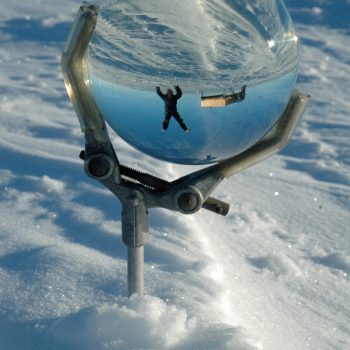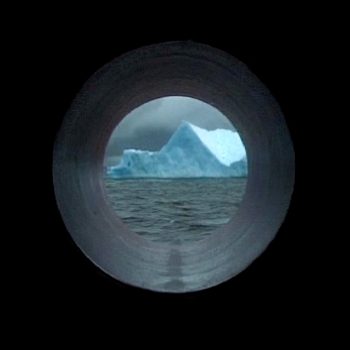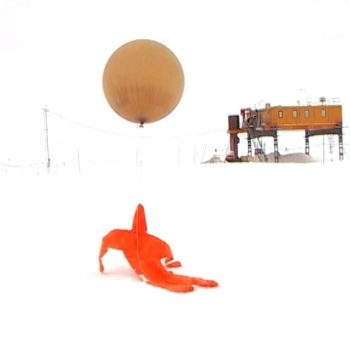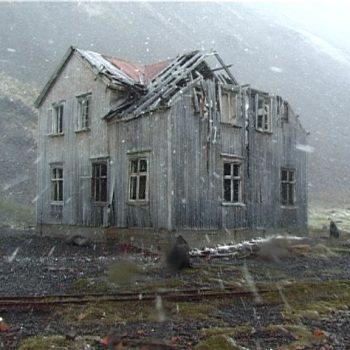Journal extracts from a two-month journey to Antarctica. Joining scientists from the British Antarctic Survey on their icebreaker the ‘RSS Earnest Shackleton’ the journey started from the Falkland Islands, and travelled via South Georgia, The South Sandwich Islands and finally to Halley Research Station on the Brunt ice-shelf of Antarctica itself.
***
26th November, The Falkland Islands:
From the air the Falklands look bleak and beautiful in a lonely sort of way. Since starting the journey from RAF Brize Norton in Oxfordshire I have been carried through various military spaces.
Ascension Island seems like it might have been invented just to provide the military with a pit-stop in the middle of the Ocean. It’s about as far from anything as it’s possible to be. Waiting for refuelling we had an hour looking out at the Volcanic landscape through the bars of our cage and then ascended once more, leaving the tiny rock to disappear into the endless Atlantic waves.
After 8 more hours we finally began to descend onto the flatter, colder east island of the Falklands.
28th November, Falkland Islands:
Who on earth would fight over this…?
The Falklands is incredibly empty. It looks like Scotland after a war. There are no trees except the sad convicts planted by the scattered residents. Stanley only seems to exist through grim determination and fleecing the cruise ships. In every direction along the water there are wooden or steel wrecks slowly giving in to the weather, and the hills are littered with bits of war machinery. I walked out of Stanley through an ice wind and eventually reached the dunes and beaches of Gypsy Cove. The sand is blindingly white and the water is travel-brochure blue, but everywhere there are warning-signs showing a one legged man and the words ‘danger mines’. Only the oblivious penguins are enjoying the cold Atlantic surf.
2nd December, Scotia Sea:
A force-ten storm. As the prow of the RSS Ernest Shackleton is built for pushing its way through ice, it means that it is far less stable in the open sea. The boat goes through all sorts of strange motions as paintings hang off the walls at an angle of 30 degrees. It’s strange the way everything is the same, but gravity just works in new directions. Plants become like triffids – spontaneously groping in one direction and then another. Towels hung over clothes-rails wave out one leg like ballet teachers. I was filming one of the paintings when an unexpected lunge, sent five people on armchairs flying past me, to end up on the far side of the bar in a tangled heap of beer and legs. Every now and then there’s a huge judder as the ship hits the bottom of a trough. The portholes all turn white and the ship ploughs through the body of the water, until it climbs again and rolls over the next crest. But with amazing luck, I seem to be immune to the seasickness that plagues my bunk-mates.
4th December, Signy Island:
Signy felt like the last conceivable outpost of mankind. Pirate, craggy needles of island covered in weird wildlife that snort and fart at you as though you have no right to be there. And in fact there hasn’t been anybody here (apart from scientists intermittently) since the whalers left a 100 years ago.
After a day delivering supplies and looking at the elephant seals, we again board our incongruously cheerful-red ship. Before reaching the ocean though we have to thread our way through the most incredible field of icebergs. The colours look like someone has messed with the RGB settings in your eyes. They vary in size from a small crofter’s cottage bobbing though the swell to huge slabs of South London housing-estate eight stories high. Some were standard snow white, some smaller bits are see-through (like huge lumps of ice from the fridge) and then there are the blues ones that seem to be glowing from the inside with a weird synthetic blue light. They vary from off-white Styrofoam blue, to a sullen brooding dark-blue – lurking with 90% below the surface.
6th December, South Georgia:
Above the waves, South Georgia’s mountains appeared and disappeared out of the banks of mist and cloud. At times it looked like a split-screen montage of ocean seascape and floating glaciers. After hundreds of miles of open sea it looked like we had happened upon a wall of Alps levitating above the waves.
Nosing its way out of the swell through twisting inlets, the Shackleton reached the abandoned whaling-station of Grytviken – glowing rust-red beneath the black and ice of the jagged skyline. The small science-station here studies marine life in their carefully chilled tanks and the whaling museum deals with cruise-ship millionaires that are carefully delivered in to the island in their identical, red Antarctic outfits.
The various islands have been scarily and beautifully bleak. South Georgia is larger (about the size of Corsica), but with no-one on it. Sailing along the coast, we stopped off at ‘Stromness’ – the abandoned whaling station where the explorer Ernest Shackleton finally found salvation. Arriving by rubber speedboat onto the crumbling jetty we entered a post-apocalypse movie – a ‘Planet of the Seals’. The Norwegian buildings are slowly collapsing but look like they were left at a moment’s notice. Cups sitting on counters, chairs still waiting at tables, and beds and baths lying empty. All of this, though, is now overrun with elephant and fur seals fighting, shitting, howling and sleeping in a post-human era with snow drifting in through the broken windows. Every room has a new cast of blubberous inhabitants sliding over the breaking remnants of early twentieth-century life.
11th December, South Sandwich Islands:
Sailing through the night towards Zavadovski Island – an erupting volcano on the northern edge of the uninhabited South Sandwich Islands. We are picking our way through fields of hidden icebergs. All the lights are out on the bridge and the only illumination comes from the arrays of blinking buttons, radar-screens, GPS monitors. Outside two powerful searchlights beam out through the fog. Trained on a small patch of ocean in front of the ship like a ballerina’s follow spot, they create an expectant circle of immanent ice. All that appears, occasionally gliding through the beam, is one of the huge wandering albatross, shining impossibly white against the black rolling sea. The air begins to lighten and the yellow blips on the radar screen show various huge bergs passing nearby, but still unseen in the fog. A fin-whale blows a jet out of the swell and rolls lazily forward as it dives away from the ship. Finally a bigger lump picked out in the ghostly yellow radar takes shape as Zavodovski itself. Hidden behind the fog, we can smell its fumes blowing in the air. In the light of dawn, we can see the nearer icebergs begin to be populated with the black dots of penguins – suburbs of the millions of ‘Chinstraps’ inhabiting the geothermically ice-free island and adding to its smell. Finally, we can just about make out the black coast at ‘Noxious Bluff’ – but the smoking mountain stays hidden in its clouds.
20th December, Weddel Sea:
Night and day the GPS screens in the bar are slowly counting up the degrees of Latitude as we get steadily further south. Incongruously, though it was ‘sunbathing’ weather on deck today. Hung-over from a party the night before, bodies lie on the sun-warmed steel. I found myself a quiet spot on the ‘monkey deck’ – right at the top of the ship, but tucked out of the wind behind the conning tower. I bask in the fierce UV sun and read Gulliver’s Travels (albeit in hat and gloves).
22nd December: Weddel Sea:
The sun has stopped rising and Christmas is approaching. Part of my onboard duties is to decorate the plastic Christmas tree – first securing it to the floor and ceiling with strong black tape. As we are now due to arrive before Christmas, carol singing was arranged on the Foc’s’le. Facing into the bitter wind, whilst the prow of the ship brakes through the ice – the mulled wine chills instantly and the singing doesn’t last much longer.
23rd of December, Antarctica:
Strange thing – but from a distance the ice cliffs of Antarctica looked vaguely like the low chalk cliffs of Ramsgate. Everything here is implausibly white and blue. Filming out of the porthole in my cabin, as they smash their way through the sea-ice to create a mooring point, I have to wear sunglasses just to look out. The snow and ice is sculpted and fractured into strange cartoon shapes. Where there’s a crack it does this trick of glowing from the inside ‘gas-ring’ blue. The path that we’ll be taking up to the station is marked out with black oil drums and black fluttering flags on bamboo poles. The path meanders up the slope and through a gap in the ice-cliffs – all very minimal Japanese styling. Scale is a weird killer here. Part of the dislocation is caused by all reference points having been removed – there’s no ‘thing’ to re-calibrate your senses against. Maybe when I can get off and look back at the boat it will start to makes sense but at the moment it’s a hallucinatory jumble of blue ice, white snow and grey sky. It feels unreal and very kitsch in places. The breaking sea-ice cracks up in huge chunks like monstrous mint cake – blue inside with a coating of fluffy white. Startled emperor penguins look on – outraged that their backyard is being demolished. I guess it does sort of look like Christmas – just a scary, grown-up, older-brother of Christmas. I’m all packed and waiting for the next Sno-Cat to take me up to the base. Standing with my baggage on the sea-ice next to the ship.
24th December, Halley Research Station:
12.05am and the sun is arking off the sparkling, undulating snow. Frail, spidery bits of humanity are scattered around a few, flat kilometers. Radio-masts, buildings on stilts, snow-cats and skidoos all buzzing and levitating across white space. Countless orange boiler-suits are busy carrying things from place to place – like an endless wide-shot of the evil empire’s HQ.
But beyond this circle of orange silhouettes – nothing.
Pure, undiluted ‘nothing‘ as far as the eye can see. Except that I have no way of gauging how far my eyes are seeing – between the flimsy bits of Halley there’s no thing’ to see.
I walked out to CASlab – the 4th building set slightly apart so that they can measure the pure air blowing across thousands of miles of empty Antarcican continent. Following the rope handline (for when you can’t see further than your feet) I was walking steadily towards the building that was just there in front of me. I walked… and I walked… and I walked… but the building didn’t seem to get any bigger. I looked back and the Simpson Platform was indeed slightly smaller. I walked some more, overheating in all my Antarctic gear. The untouched snow (unbearable to look at without goggles) was alive with crystal fireflies of light but for all my clown-walking in huge moon-boots, the shimmering building ahead only grew a tiny amount – floating through infinity white. An evil angel was playing with me – blowing the building away across the featureless plain of white. If your eyes tell your brain things that don’t make sense, your brain tries to fill in.
Distance is totally screwed, space is warped and time packed-up and went home. Nothing seems real – I think I’d better draw the blinds as tight as I can and try and sleep.
28th December, Halley Research Station:
This is a bizarre place – not scenic at all (in a traditional sense) just flat, and insanely white. The light is so intense its like the world has been deleted. The windows on the platforms all have thick blinds and their frames have added flaps of plywood to try and create a light seal – but still the glare seeps through like bleach.
I go round and round trying to find words and metaphors that will describe this.
Part of the problem is that it’s not actually a place. The oblivious, flat ice shelf surrounds the structures on all sides. There’s no topographical reason for the platforms to be placed here. Someone just decided – took out an empty white map and drew a cross. Because of ‘windtails’ (banks of snow that form down wind of anything left on the surface) the platforms are not huddled together but lie paradoxically far away from each other. Alone like neurotic patients quivering in the middle of a field. The platforms look like miniature, ad hoc oil-platforms. Each year they have to jack them up another meter on their stilts to stop them disappearing beneath the snow. And each year the ice-shelf itself slides another 50 meters further out to sea. The whole thing seems insanely arbitrary, makeshift and pointless. Perched like frozen insects on an iceberg waiting to happen. Globally important science is going on here, but somehow against the scale of Antarctica it all looks slightly ridiculous and frightened.
Part of the reason for the base to be here is to maintain a British presence. Like the scramble for Africa, Antarctica was carved up in-case it turned out to be useful. In this instance, though, the carving was very neatly done with each country’s slice radiating out from the South Pole. Neat that is, except for the fact that Argentina, Chile and Britain all claim the same slice.
To bolster their territorial claim, Argentina flew in a pregnant woman to give birth on their base. The Chilean’s responded by bringing several couples to live, conceive and have children – and the British opened a post office. Perhaps in a misguided quest for normality, I got the postmaster (who is also the base commander) to open up the post-office. Housed in a metal trunk beneath his desk, I bought postcards of an ice-encrusted base beneath an aurora sky and stamps featuring a silhouetted Queen’s head floating above an ice-shelf.
2nd Jan, Weddel Sea:
2.30am and we’re sailing along the ice cliffs – leaving this strange place.
Antarctica is getting smaller and the sea is becoming clearer.
3rd Jan, Weddel Sea:
The ghost ship is quiet after all the madness. On the trip down the boat had every available bed filled and all the space above and below decks crammed with supplies for the various bases. On the way back, though, it’s just the crew and five lost souls traveling with the rubbish that’s being transported back. One dentist, two doctors, Dr Ice (as the Portuguese iceberg scientist was called) and one artist.
I’ve been sleeping for a thousands years, luxuriating in the relative expanse of a now empty cabin. The top bunk means that I can now watch the icebergs drift by as I’m rocked by the boat – falling in and out of sleep.
Sanity levels are slowly returning to normal.
5th January, Weddel Sea:
My sleep is totally confused. Last night it got dark for the first time in weeks. I lay in my bunk happily sleepless, imagining people in the real world and listening to the sea snoring.This morning I saw a seal out of my porthole. Flopped on the pack-ice – awoken by the approaching ship.
10th January, Stanley:
The RSS Earnest Shackleton made it to the Falklands just in time for last orders. Once the gangplank was down, we raced to the nearest pub – a typically ugly Stanley building on the edge of town, but at least it has a pool table.
Pool is a game I love even when I don’t win. It consists of a mathematical purity of angles, velocity, spin and momentum but it also requires a very visceral melting of your body into a perfect Euclidean space. A space where you are lost if you try to measure degrees but rather, if you are on form (and tonight I was), you can feel the angles, sense the cause and effect and even perhaps detect the slight warps in the fabric of space and time (although perhaps this was the table).
Tonight, however, this feeling was eclipsed by the wonderful appreciation of a place that was still enough for pool balls to stop rolling. In the empty bar even the monosyllabic bartender was charmingly still. After two months in a shifting, unreal world of water and ice the Falklands now felt intoxicatingly normal.
Outside, the air seemed to have found some peace and was also unusually still. We walked back along the shoreline of Stanley Sound, through tussock grass, past Upland Geese and beneath unfamiliar stars.
11th January, Above the Sahara:
On our way to the military base to board our plane back to normality, we passed a new attempt at growing trees. A huddle of sad, waist-high conifers hunched right over and dead on one side. They could be useful if you needed to know the direction of the prevailing wind – except that you never would, because invariably the same wind would be clutching at you, also shaping your body into a lopsided hunch.
Right now, though, I’m miles above the Sahara desert with the icebergs still gliding in my mind. The journey back, with the other stragglers ejected from the land of whiteness, is crackling in my brain. Watery molecules of memory are slowly forming in the strata of my mind. Moments becoming images. Dancing late into the night in the hot, rolling bar, of the RSS Earnest Shackleton. Staggering drunk and dripping into the frozen moonlit air. Alone on the deck with the ghost-blue icebergs, drifting silently through a black and bottomless sea.



